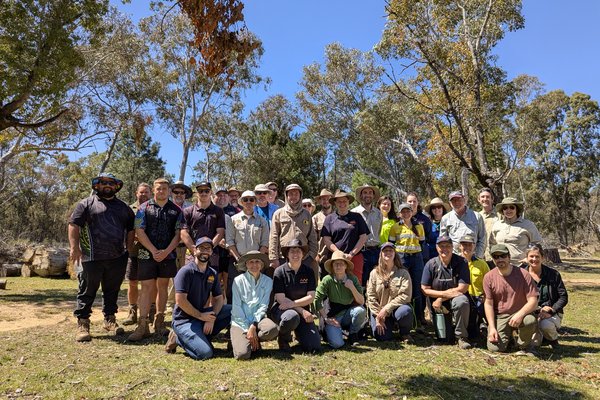Looking back to move forward: traditional knowledge and genetics informs threatened species management
Knowledge from traditional owners and modern genetics has enabled improved management of the black-footed rock-wallaby in South Australia
The central Australian race of the black-footed rock-wallaby (Petrogale lateralis), known locally as warru, is one of the most endangered species in South Australia. The three surviving populations in the far north of the state are genetically differentiated suggesting independent management may be appropriate. However, traditional knowledge and genetic analysis of populations throughout central Australia show historical connectivity indicating that remaining populations should not be managed independently.

© Australian Museum
Warru were once widespread throughout central Australia. In South Australia, they have suffered a 93% reduction in distribution, with only ~ 250 individuals remaining at three sites in the far north-west of the state on the Anangu Pitjantjatjara Yankunytjatjara (APY) Lands. Two of these populations were found in the Musgrave Ranges about 12 km apart, while the third was ~ 300 km to the west in the Tomkinson Ranges. A Warru Recovery Team was set up in 2007 with the aim of reversing the decline in warru in the APY Lands. The Recovery Program was overseen by a group of senior local women (warru minyma) and worked with indigenous Rangers employed by APY Land Management through Commonwealth Working on Country funding. In 2007 a captive breeding program was established at Monarto Zoo, SA with individuals sourced from the three remaining SA populations. Between 2007 and 2011, 28 individuals were transferred to Monarto Zoo and Musgrave Ranges animals were bred together to provide individuals for future reintroductions. Genetic information at the time suggested the Tomkinson Ranges individuals should be kept separate to preserve their unique genetic diversity. During 2011 and 2012, 16 captive Musgrave Ranges warru were released into a 97 ha fenced exclosure on the APY Lands.

© Liberty Olds
In order to guide ongoing management of the wild and captive populations we examined the levels of genetic diversity within and between the surviving wild and captive populations. We used two types of genetic markers, microsatellites which give information about more recent genetic mixing, and mitochondrial DNA which gives information about historical mixing. The genetic data from the microsatellites revealed that current warru populations were genetically different, although we found evidence for recent dispersal between some populations. However, the mitochondrial DNA suggested a weak pattern relationship between genetic differences and geographic distance which suggests the populations were historically much more connected. This is consistent with traditional knowledge which recalls warru being much more widespread and common throughout the mountain ranges of the APY Lands in the past, which would have provided the opportunity for gene flow across the landscape. In addition, our study found that the levels of genetic diversity within the current captive populations was lower than in the wild populations, and that supplementation with additional unrelated animals is needed to avoid inbreeding.

© Warru Recovery Team
Based on traditional knowledge, as well as our genetic data and ecological observations we recommended that the captive populations be managed as one genetic group, that incorporates individuals from all three surviving warru populations. This will increase the genetic diversity of the captive population and improve the genetic diversity of reintroduced populations established with captive bred individuals, which will make these populations more likely to adapt and survive future changes (such as disease or changes to environmental conditions).
During our study we also identified a new population of wild warru in the Musgrave Ranges which contained unique genetic diversity. This novel diversity is a potentially valuable source for future supplementation for both the existing wild and captive populations.
Our recommendations are now being implemented by the Warru Recovery Team to manage warru genetics. Breeding of Musgrave and Tomkinson Ranges individuals has started at Monarto Zoo, and Tomkinson Ranges individuals have been released into the exclosure with the warru of Musgrave Ranges ancestry. In 2017, the first reintroduction of warru on the APY Lands occurred outside the exclosure, with a release group containing Musgrave Ranges and mixed descent animals from the exclosure. Over the next few years, the Warru Recovery Team will continue to collect genetic samples from new individuals in each population to determine if Musgrave and Tomkinson Ranges animals are successfully breeding and how this is influencing genetic diversity in each population.
Dr Rebecca West, PhD student, AMRI, Wild Deserts Ecologist, University of New South Wales, Sydney
Dr Sally Potter, Research Associate, AMRI, Postdoctoral Fellow, Australian National University
Dr Mark Eldridge, Principal Research Scientist, Terrestrial Vertebrates, AMRI

© Rebecca West
More information:
- West, R., Potter, S., Taggart, D. and Eldridge, M.D.B. 2018. Looking back to go forward: genetics informs future management of captive and reintroduced populations of the black-footed rock-wallaby Petrogale lateralis. Conservation Genetics 19: 235-247.
Acknowledgment:
We would like to thank the Anangu Pitjantjatjara Yankunytjatjara Executive Board for providing approvals to conduct the project. Funding for the study was provided by the Warru Recovery Team, Norman Wettenhall Foundation, Margaret Middleton Fund, Sir Mark Mitchell Research Foundation, Nature Foundation SA (Edwards Majory Scholarship) and Adelaide Off Road. Fieldwork was conducted by various members of the Warru Recovery Team and a fantastic team of volunteers. We thank Anangu tjuta for supporting the project.











